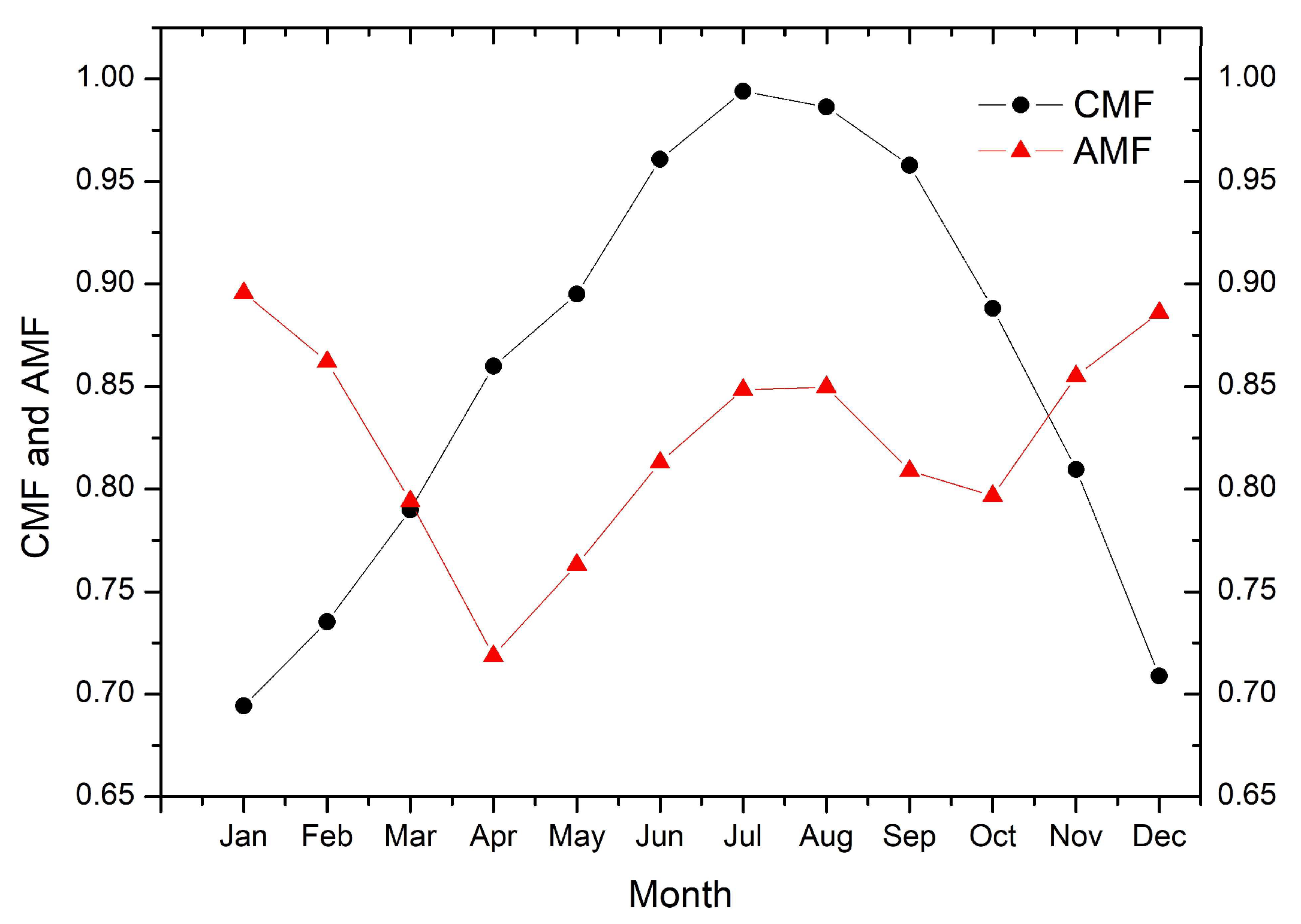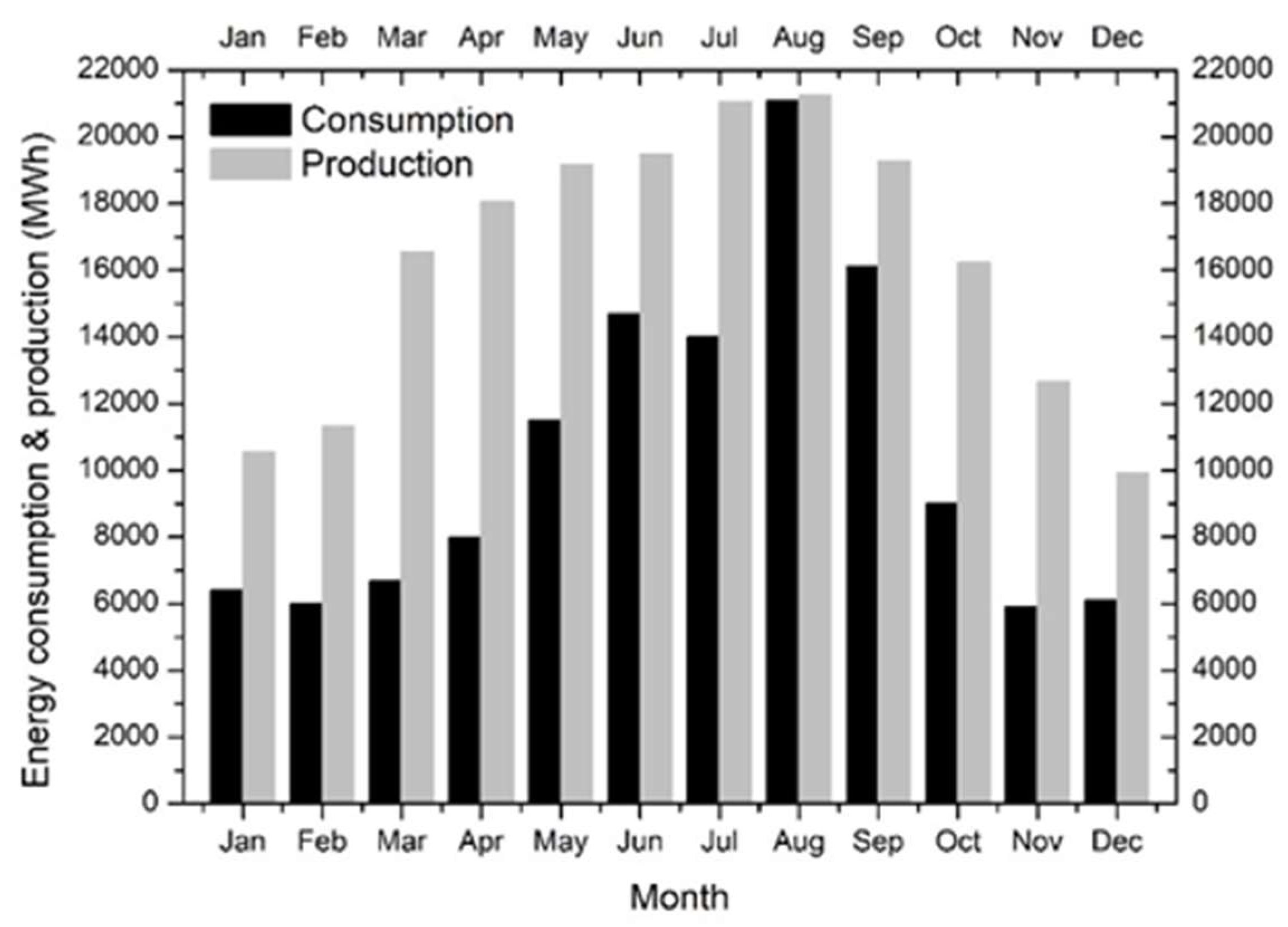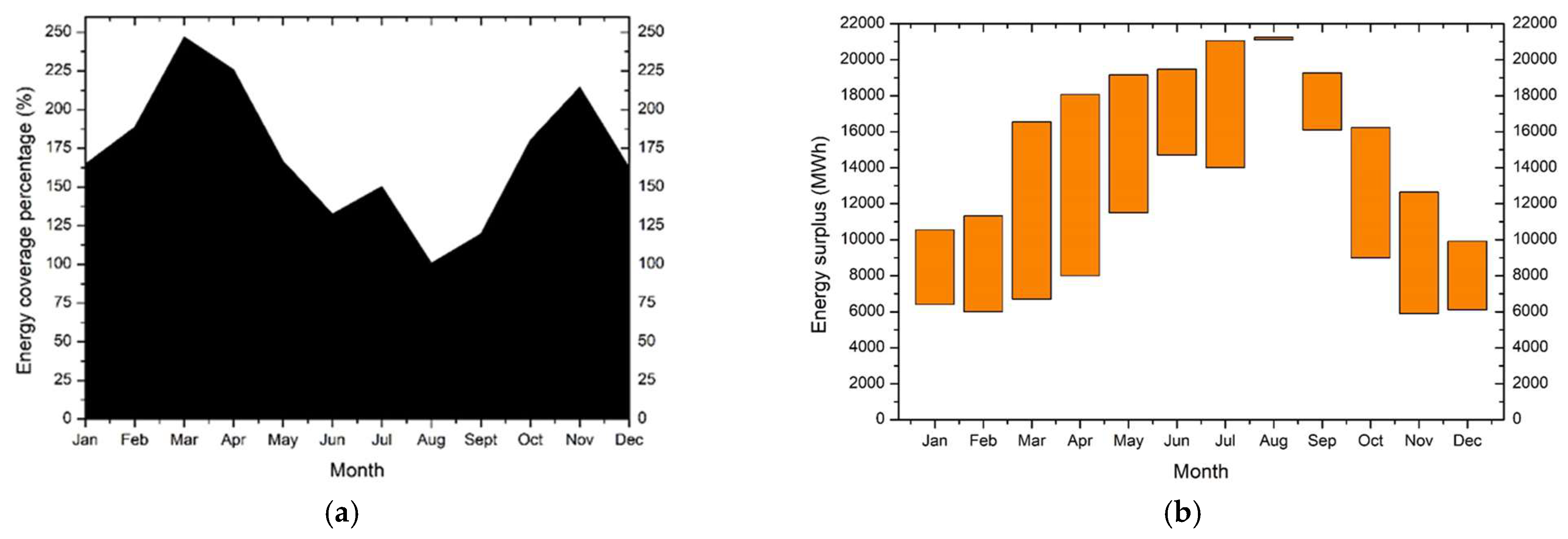Energy Autonomy Scenario for the Island of Mykonos in Greece with Solar Power Plants †
Abstract
:1. Introduction
2. Materials and Methods
2.1. Solar Radiation and Energy Simulations
2.2. Financial Analysis
3. Results
3.1. Aerosol and Cloud Effect on Solar Radiation
3.2. Energy Planning Scenario
4. Discussion
5. Conclusions
- A CS 120 MWp PV system exceeded the energy target during the whole year, and an area of 2,426,748 m2, namely, 2.8% of the whole island, would be required.
- PV panels with latitude-based tilts produce 10.06% more energy than the horizontal ones, and were thus preferred for the demonstration of the system. The cloud effect on the scenario’s energy production was measured to cause a 10.94% loss, while the effect of aerosol was measured to cause a 16.5% loss.
- The calculations used in the financial analysis showed a total system revenue of 54.158 million EUR, followed by a 8.16 and a 12.31 million EUR loss due to clouds and aerosols, respectively. However, there was also a 93–100 million EUR loss due to the lithium battery that would be required.
- The installation of the 120 MW PV system that concludes with the lithium battery that supplies the island with energy during night time or under bad weather conditions costs 22.35–25.15% lower than the programme of IPTO S.A.
- The energy surplus of 70,003 MWh (i.e., 19.39 million EUR) in combination with the interconnection of Mykonos with the rest of the grid provides an opportunity for the island to enhance its economy by distributing energy in excess with the rest of the grid.
Author Contributions
Funding
Institutional Review Board Statement
Informed Consent Statement
Data Availability Statement
Acknowledgments
Conflicts of Interest
References
- GREECE. Available online: https://www.visitgreece.gr/islands/cyclades/mykonos/ (accessed on 12 May 2023).
- RAE Regulatory Authority for Energy-Non-Interconnected Islands—2022. Available online: https://www.rae.gr/non-interconnected-islands/?lang=en (accessed on 27 April 2023).
- Wikipedia. Available online: https://el.wikipedia.org/wiki/%CE%9C%CF%8D%CE%BA%CE%BF%CE%BD%CE%BF%CF%82 (accessed on 27 April 2023).
- Katsoulakos, N.M. An Overview of the Greek Islands’ Autonomous Electrical Systems: Proposals for a Sustainable Energy Future. Smart Grid Renew. Energy 2019, 10, 55–82. [Google Scholar] [CrossRef]
- Solar Radiation Data for Professionals. Available online: https://www.soda-pro.com/ (accessed on 4 July 2023).
- Photovoltaic Geographical Information System. Available online: https://re.jrc.ec.europa.eu/pvg_tools/en/tools.html (accessed on 4 July 2023).
- Average Monthly Electricity Wholesale Prices in Selected Countries in the European Union (EU) from January 2020 to July 2023. Available online: https://www.statista.com/statistics/1267500/eu-monthly-wholesale-electricity-price-country/ (accessed on 7 May 2023).
- Kosmopoulos, P.G.; Mechilis, M.T.; Kaoura, P. Solar Energy Production Planning in Antikythera: Adequacy Scenarios and the Effect of the Atmospheric Parameters. Energies 2022, 15, 9406. [Google Scholar] [CrossRef]
- STATISTA. Available online: https://www.statista.com/statistics/883118/global-lithium-ion-battery-pack-costs/ (accessed on 4 July 2023).
- IPTO, SA. Available online: https://www.admie.gr/en/company/admie-group/ipto-sa (accessed on 11 May 2023).
- Cyclades Interconnection Phase A Paros-Syros-Mykonos. Available online: https://www.admie.gr/en/erga/erga-diasyndeseis/diasyndesi-kykladon-fasi-paros-syros-mykonos (accessed on 11 May 2023).
- PTO. Available online: https://www.admie.gr/en/erga/erga-diasyndeseis/diasyndesi-kykladon-b-fasi-andros-tinos-naxos (accessed on 11 May 2023).
- Average Installed Cost for Solar Photovoltaics Worldwide from 2010 to 2021. Available online: https://www.statista.com/statistics/809796/global-solar-power-installation-cost-per-kilowatt/ (accessed on 11 May 2023).





Disclaimer/Publisher’s Note: The statements, opinions and data contained in all publications are solely those of the individual author(s) and contributor(s) and not of MDPI and/or the editor(s). MDPI and/or the editor(s) disclaim responsibility for any injury to people or property resulting from any ideas, methods, instructions or products referred to in the content. |
© 2023 by the authors. Licensee MDPI, Basel, Switzerland. This article is an open access article distributed under the terms and conditions of the Creative Commons Attribution (CC BY) license (https://creativecommons.org/licenses/by/4.0/).
Share and Cite
Nasioula, A.; Kosmopoulos, P.G. Energy Autonomy Scenario for the Island of Mykonos in Greece with Solar Power Plants. Environ. Sci. Proc. 2023, 26, 10. https://doi.org/10.3390/environsciproc2023026010
Nasioula A, Kosmopoulos PG. Energy Autonomy Scenario for the Island of Mykonos in Greece with Solar Power Plants. Environmental Sciences Proceedings. 2023; 26(1):10. https://doi.org/10.3390/environsciproc2023026010
Chicago/Turabian StyleNasioula, Agathi, and Panagiotis G. Kosmopoulos. 2023. "Energy Autonomy Scenario for the Island of Mykonos in Greece with Solar Power Plants" Environmental Sciences Proceedings 26, no. 1: 10. https://doi.org/10.3390/environsciproc2023026010
APA StyleNasioula, A., & Kosmopoulos, P. G. (2023). Energy Autonomy Scenario for the Island of Mykonos in Greece with Solar Power Plants. Environmental Sciences Proceedings, 26(1), 10. https://doi.org/10.3390/environsciproc2023026010






